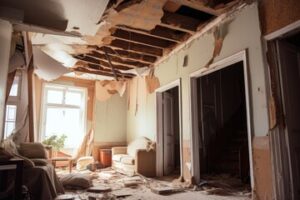Water damage can be a huge problem in your home. It can cause mildew and mold growth, wood swell and warp, metal to rust, and bio-hazard contamination.

The severity of the damage can be determined by what category the water belongs to, and it can become more dangerous if left untreated. This is why it is important to hire professional Water Damage Restoration Utah services.
Removing The Standing Water
Standing water can create a wide range of issues if not removed quickly. It can damage carpeting, drywall, wood floors, and other structural materials. Additionally, the contaminated water can spread pathogens that can make people sick. This can include bacteria, viruses, and fungi such as mold. It can also contain algae that produce toxins.
If you experience any signs of water damage, it’s important to call a professional right away. They will be able to assess the situation and use tools like moisture meters and thermal imaging cameras to determine the extent of the damage. They will also use industrial-grade pumps and wet/dry vacuums to remove the water. They can also use dehumidifiers and air movers to dry the area and eliminate unpleasant odors.
Before any restoration work begins, it’s vital to prioritize safety and turn off electricity and gas in the affected area. Water can cause serious electrical problems, so it’s important to turn off power sources in the area to avoid electrocuting yourself or anyone else working on the restoration. You should also open any windows and doors in the area to allow for ventilation and help the area air out.
The first step in water damage restoration is removing the standing water as quickly as possible. This can be done by hand using buckets and mops, mopping with towels or rags, or with large commercial fans and dehumidifiers. It’s also a good idea to move any items that can be easily moved out of the area, such as furniture and appliances.
It’s also a good idea to take photos or videos of the affected areas and damaged belongings for documentation purposes. This can be useful when submitting an insurance claim. It’s also important to keep a detailed record of communication with insurance providers. Finally, it’s a good idea to research potential restoration companies before hiring them. Look for a company that has experience in water damage restoration, a good track record, and certified staff. If possible, try to get recommendations from past clients. They may be able to provide you with more details on their services and equipment.
Dehumidifiers
Dehumidification is a vital step for water damage restoration. Remediation companies rely heavily on this process to remove excess moisture and ensure that structures are dry before moving on to the restoration phase. The moisture that remains in a structure can lead to significant issues, including structural damage, mold and mildew growth, and health risks. To prevent these issues, it is important to hire a remediation company with high-quality and efficient equipment.
In addition to dehumidifiers, professional remediation services also utilize high-powered fans and specialized drying equipment to speed up the process. They may also use a series of sensors to detect moisture in hard-to-reach places. This allows them to quickly identify areas that need more attention and get them dried out before the moisture causes more damage.
A good dehumidifier for water damage works by drawing in humid air and cooling it to condense the moisture, then releasing the drier air back into the environment. This significantly reduces the humidity level in the space, creating an environment that is less prone to mold and mildew growth. These machines are available in a wide range of capacities to suit different spaces and conditions, but commercial dehumidifiers are engineered for higher capacity usage and more severe humidity problems than their residential counterparts.
If left unattended, water damage can escalate rapidly and cause severe consequences for homeowners. Even water from a clean, sanitary source like pipes or rainwater can create substantial issues if not dealt with immediately, causing the wood to warp and swell and metal to rust and corrode. Additionally, severe water damage can lead to dangerous biohazard contamination that requires a thorough restoration and cleanup process.
The quickest way to reduce the risk of water damage is by knowing where the water shut-off valve is located and how to turn it off in an emergency. It is also a good idea to regularly inspect appliances that use water, such as washing machines and dishwashers, to ensure they are functioning properly.
A new type of moisture-eliminating equipment, known as intra-wall drying, helps to reduce the time it takes for walls to dry by using a forced air approach. The process involves drilling small holes into the base of the wall and then forcing air into the cavity behind the drywall, significantly cutting down the drying time.
Drying The Areas
After removing standing water, restoration professionals must also dry the affected areas. This is a crucial step as moisture that’s left unaddressed can seep into building materials, compromise their integrity, and create an ideal breeding ground for mold and mildew. Proper drying eliminates these problems and restores a safe and healthy environment.
Air movement is a fundamental part of the drying process. Restoration specialists use large fans and dehumidifiers to create a consistent flow of air over wet surfaces, which enhances the transition of moisture from liquid to gaseous state. This helps speed up the drying process and prevents the onset of unseen mold growth and structural damage.
Moisture detection tools and thermal imaging cameras are also used to monitor the progress of the drying process. These tools allow restoration experts to pinpoint hidden water sources and identify problematic areas. They can then make targeted adjustments to the drying equipment and optimize the results. In addition, humidity sensors and timers are often installed on restoration equipment to ensure the proper shut-off of equipment when moisture levels have reached a desirable level.
It’s also important to check behind walls, under floors, and in the attic, where moisture can seep into insulation materials or stored boxes. By catching these issues early, you can save on costly repairs and avoid long-term health risks.
After the drying process is complete, a comprehensive assessment of structural integrity and damage is conducted. This will inform a plan for restoring and repairing the property to its pre-damage condition. This may involve replacing damaged materials, repairing structures, and addressing cosmetic issues caused by the water event. Depending on the extent of the damage, this phase could take several days. During this stage, personal belongings that are too water-logged or contaminated to save can be removed and temporarily relocated. This service is called “pack outs,” and it’s usually covered under your homeowner’s insurance policy. During pack-outs, restoration specialists can clean and sanitize items to remove contaminants and odors. They can even use thermal and ULV foggers to disperse deodorizing chemicals into a fine mist or fog that penetrates deep into porous surfaces, eliminating unpleasant odors.
Structural Repairs
Water damage is a homeowner’s worst nightmare, destroying belongings and leading to costly repairs. However, prompt action can mitigate long-term damage and depreciation of property value. The key is understanding the importance of water restoration and finding a team of experts with the right knowledge and experience to help you through this stressful time.
Whether caused by a burst pipe, severe weather, or a malfunctioning appliance, water damage requires immediate action. If left unattended, water can cause extensive and expensive structural damage that weakens a building’s foundation and leads to sagging, cracking, and collapse.
The first step in the water damage restoration process involves identifying and controlling the source of the water, which could range from clean rainwater to contaminated sewage and floodwater. Once the source has been controlled, professionals use specialized equipment to pump out standing water and dry the affected areas. This includes submersible pumps, wet vacuums, air movers, and dehumidifiers to remove water and ensure the area is completely dried out.
In many cases, it is necessary to tear out materials like drywall down to the studs and carpeting down to the subflooring to ensure that all areas are properly dried and sanitized. This can speed up the drying process and allow for more thorough cleaning of the underlying materials, including the wood framing. It is also a good idea to work closely with your insurance company to make sure that all costs are covered.
A comprehensive water damage restoration plan addresses both immediate concerns and long-term impacts, ensuring that the property is returned to its pre-damage condition. This may include a thorough inspection and repair of the structure, replacing or repairing damaged flooring and drywall, and installing new insulation. It is also a good idea to replace old appliances and fixtures with more efficient models that are less prone to water damage.
Regularly inspecting appliances and fixtures for signs of leaks or corrosion can help homeowners prevent water damage before it occurs. Homeowners can also reduce their risk by upgrading their homes’ plumbing systems, installing water leak detectors in high-risk areas, and implementing smart home technology to monitor the water supply and provide alerts of any problems.
